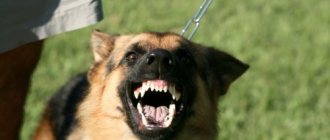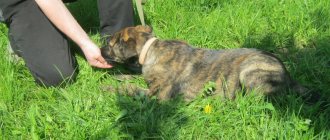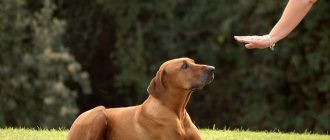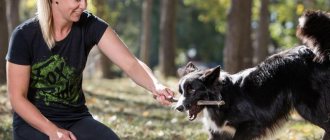Training is the purposeful preparation of dogs in order to develop certain skills in them, which may or may not be mandatory. The command “Give me your paw!”, which does not have much functional significance, is an optional skill. Mastering it is necessary for the overall development of the dog. Although often the command has a functional meaning and is useful in life, so you can spend time teaching your pet this skill. You can teach your dog the command “Give me your paw” both as an adult and as a puppy.
Can all breeds give a paw?
If the dog is healthy and this movement does not cause him pain, then it is possible to train him. How long this will take depends on many factors.
Many believe that breed is the main factor in trainability in this process. Scientists give ratings of dogs that are genetically tuned to training. They are probably right about something.
In such a dog school, poodles, retrievers, and German shepherds are among the top students.
I would also add “door terriers”. Among the mongrel brethren there are often very smart individuals. But in the gallery there are such “unheard” representatives of breeds as the Afghan Shepherd, Basset Hounds, Mastiffs and Pekingese.
Personally, I have been living with just such an “unteachable” person for the last 12 years. From personal experience I can say: do not rush to label your dog just because he is on the list of difficult to train breeds. If there is a desire to teach at least some command, then it will be fulfilled. The “Give me a paw” command is one of the simplest.
Why is the “give me your paw” command needed?
Dog trainers consider the commands “place”, “come to me”, “no” to be mandatory and recommend starting dog training with them. But the command “give me your paw” is considered optional, since it does not have sufficient functionality. However, you should not consider it as a whim of the owner or some kind of game. “Give me a paw” you will need:
- when wiping paws after a walk;
- nail trimming;
- possible injuries;
- examination by a veterinarian.
Dog gives paw to man
Also, any cooperation with a person disciplines the dog.
The command will be needed when trimming nails
Are all dog owners able to teach their pet commands?
I can definitely say that everyone can do it. The question is whether everyone will want it.
It often happens that novice dog breeders make mistakes in training. There is no understanding between man and animal, and everything goes wrong.
This situation is completely normal. Dog breeding needs to be learned both in practice and in theory. It can and should be corrected by seeking the help of a dog handler.
My Pekingese and I took several lessons. Believe me, it was worth the time and money. The level of respect my proud “little lion” has for his owner has noticeably increased.
And I was not alone in my search: in our group, along with shepherds and Rottweilers, Pekingese and dachshunds were engaged. And for each dog the lessons were beneficial. Highly recommend.
Such classes give the main thing: you will learn to understand each other. And without that, there can be no talk of any training. Even the smartest dog will seem like a stupid, harmful beast to you.
A properly trained dog:
- He behaves calmly and balanced. Doesn't attack passers-by or cats, doesn't bite.
- Reacts calmly to passing cars, motorcycles and other surrounding noise sources.
- He tolerates going to the toilet before walking, or defecates in a specially designated place.
- Eats on schedule, does not beg or steal food from the table.
- Knows his place, does not go where it is forbidden (for example, on the master's bed).
- Does not cause a pogrom in the apartment (house) after the owner leaves for work, patiently waits for his return.
- Does not chew or scratch furniture, doors, or floors.
- Doesn't bark for no reason, especially at night.
- Loyal to its owner, an excellent companion dog.
What you can teach a Chihuahua:
- overcome obstacles on a special obstacle course;
- bring and look for things (objects);
- dance or howl to music;
- walk on front or hind legs;
- guard and protect the apartment or the specified item (thing);
- give a paw or bark when ordered;
- be a guide for a visually impaired owner;
- carry a leash or a small object (newspaper) in your teeth;
- speak simple words (for example, mom);
- perform commands and tricks;
- go to the toilet in a diaper (in the tray).
Training: teach or force?
It's probably clear what we're talking about. What style of behavior to choose when you start a lesson. Someone adheres to totalitarian behavior, someone is ready to tolerate careless treatment of themselves, just not to be a rude dictator.
I am against dictatorship, but anarchy and a dog won’t work either.
A dog is a herd animal, so it obeys its leader. For her to recognize the main thing in you, a certain fortitude is required. But at the same time, with kicks, pokes and constant yelling, you can achieve only one thing: the dog turns into a frightened, intimidated animal with its tail between its legs.
In addition, from experience I can say for sure: not a single blow, accidental or intentional, will pass without a trace.
It will affect the return, and then you will be at the veterinarians. The expression “take care of your health from a young age” also applies to dogs. But you shouldn’t cooze with your dog, even if it’s a Pekingese, as in my case. The case is very difficult.
My little cute dog has reminded me more than once that he is blue, of royal blood, and not some trained poodle. If he wants, he does it. He doesn’t want to, turn his face to the side, and at least hurt himself! I was looking for options. Found it! More than anything in the world, my Senechka is afraid that he will be left, abandoned.
When disobedience went beyond all limits, I left the leash on the ground and pretended to leave. A minute later he was running to me, reprimanding me and almost crying.
For a week or two after that he was the most obedient dog. But I didn’t want to abuse this method. And it doesn’t apply to all dogs. Find your lever.
General rules for self-training a dog
You can teach your dog to give his paw at home. If you see progress, you can learn other commands. To do this, you should adhere to the following training program:
- You need to develop a stern voice, and for each command you need to define a certain intonation.
- To get feedback from your pet, you need to repeat the voice command 2 times. If the dog follows the command, you should give it a treat.
- If the task is perceived negatively, you need to calm the dog down with safe words. Under no circumstances should you hit or scold your pet.
- Training must be done regularly. It is advisable to repeat tasks every day at the same time.
- Before you start working out the program, you need to walk the animal in the fresh air. This will help him throw out excess energy.
Important! If the dog does not always give his paw willingly, then it is better to contact a specialist. Many dog handlers claim that dogs learn commands better in a team environment.
The main rule of training is discipline.
In the process of working out the training program, the owner needs to be persistent and strict, but not show aggression towards the ward.
Are all breeds trainable?
Not every breed is easy to train. There are types of dogs that take a long time to mature, which complicates the learning process. It is very difficult to train representatives of such dog breeds as:
- Shih Tzu;
- basset hound;
- mastiff;
- beagle;
- Pekingese;
- blandhind;
- Russian greyhound;
- chow-chow;
- bulldog;
- Basenji;
- Afghan hound.
There are dogs that make good contact and are trainable. These are, for example, Chihuahuas, Spitz, German Shepherds, Labradors. Therefore, when choosing a pet, you should pay attention to the makings of the breed.
Where to start learning?
For the dog to understand what is wanted from it, let it know that the lesson has begun. That is, make her listen to the person’s words. The animal's learning begins with the development of concentration.
It is necessary to make eye contact. Place him opposite you, and, if possible, take a position at the same level. That is, sit on your knees in front of the dog.
At first, the dog, especially in puppyhood, will be constantly distracted. It is more interesting for her to run after a toy, roll over on her back in the hope of begging for a belly scratch. But we need to let her know that work has begun.
Reward the dog for sitting for a long time, for the fact that for some time he follows your gaze and listens to your speech. This is the first lesson. But don't drag it out.
Step by step learning methods
For a tasty treat and for affection - this is the basis of team training. You can use treats and approval as rewards.
Puppy
From the age of three months, the puppy is just getting acquainted with the world, getting to know it, and learning basic skills. There is no point in demanding more from him. If during this period he lives with his mother, then the process of education is easier. He will definitely copy her behavior. And if a parent knows how to execute the command “Give me your paw!”, then teaching this to your son or daughter will be much easier.
If the baby has already been taken away from its mother, then all hope lies with the owner, how competently he will behave, how subtly he will feel and understand his pet.
Adult
If the dog is smart and quick-witted, then you can start teaching commands as early as 4 months. It will not be too late to teach the command “Give me your paw” to a dog aged 3-4 years.
The older the dog gets, the longer the training period will be. But even in old age, the dog will try to understand the owner’s desire if there is a warm, friendly relationship between them. In the eyes of such a dog one can simply read the desire to somehow please his owner.
Small breed
I can’t say that raising small dogs is more difficult than raising large ones. It’s just that the owners pay little attention to their training. If the owners of such serious breeds as a shepherd, Rottweiler and other large dogs are simply forced to teach at least basic commands, then cute companion dogs often easily avoid lessons.
Knowing the power of their charm, they skillfully use it. But if the goal is set, these dogs are also trainable. As a rule, they are smart, artistic, and love the attention of both their owners and strangers. This is where you can play.
The difference in training success is caused not so much by breed as by temperament. Some are lazy and difficult to force to follow a command. Others are so fidgety that you need to be patient to get them to listen to their owner.
Addition - “give me another paw”
After the dog has mastered the “give paw” command, it is time to teach the more complex “give the other paw”. But you should start practicing it only if you have successfully mastered the first command. How to understand this:
- the puppy reacts to the voice immediately, without waiting for repetition or treats;
- carries out commands equally clearly in any place and with different stimuli;
- the pet consciously raises its paw and holds it for a while without convulsive movements up and down.
How to understand that a puppy has successfully learned a command
How to teach a dog the command “give me the other paw”? The training technique is not much different. When learning additional commands, it is recommended to use the method without using treats. After performing “give me a paw,” they say “give me another paw” and touch the desired limb. As soon as the pet performs the necessary actions, it should be praised.
For your information! The dog can be taught to give not only its front paws, but all four in turn. This is very convenient for washing paws after going outside. But the puppy should give the other paw only when the previous one is lowered to the ground.
Training with treats
Favorite food will help you quickly master the command. Convenient when the dog loves dry food. Then the goodies don’t get your hands dirty and don’t crumble into small crumbs. The dog quickly eats them and wants more.
It’s more difficult when the dog eats natural food. It is better to immediately eliminate rewards with sugar. You don’t wish your pet harm.
You can use dry meat and small crackers. In my case it was pieces of bread.
This is also very harmful: baking is not good for the dog. But my justification can be the difficulties with this breed.
Attention, before choosing a treat, make sure that the dog is not allergic to this product.
Senya turned out to be a great baker. He is ready to do a lot for baking. He has no such love for meat. If you eat meat from a bowl, then this is a special gift to the owner, a kind of favor. He even stood on his hind legs for a freshly baked bun! I also learned to give a paw.
If the dog has a simpler character, then I would advise teaching the command with verbal encouragement. Then the animal will not be tempted to speculate on the acquired skill and beg for food, giving a paw when not asked.
The mongrels who used to live in our family did not know that a paw could get something tasty. They always gave a paw, with pleasure, and many times: one, another, two at once!
Their teaching was casual, not serious. But they figured it out quickly. If only they would take their paw and pet them for this!
The algorithm for training for a tasty treat is simple:
- Hold the treat in your hand and let your dog sniff it.
- She may begin to unclench her palm, shake her hand, or pry it with her nose. Then he touches it with his paw. This is the moment when you need to encourage her.
- Give a treat and praise.
- Repeat several times.
It may happen that the dog understands everything from the first lesson. Maybe even the second time she won’t understand that he wants her as her owner.
Let the lessons not be drawn out. Still, the main thing in communicating with dogs is joy. That's why we take them. Don't be nervous if things don't work out. Give the animal time to figure it out.
"Give me another paw"
If the owner has already instilled a basic skill in his four-legged “student,” the skill can be further developed. To do this, the dog is given an already familiar order, but after it gives its familiar paw, its remaining “support” is carefully removed and taken into the hand. This position is maintained for several seconds. After just a couple of approaches, the dog will learn to give one or the other paw.
This is not an independent team, but a variation of its basic form. That is why pets usually offer one or the other limb to a person, even when they are not asked to do so.
Training without treats
- Getting the dog ready to work.
- We give the command.
- We touch the paw. If she doesn’t give it to her, we ourselves take the paw into our palm.
- We actively praise.
- We repeat several times.
The right attitude at the beginning of the lesson is important. The dog has calmed down, is not eager to escape, and looks into the eyes of his trainer.
An experienced dog handler, that is, you, gives the command “Give me your paw,” touches the paw with your hand, takes it in your hand and encourages it with words and voice: “Well done!” Release your paw and repeat again.
Until you and the dog get tired of it. That is, a minute or two, no more. Then cuddle toys and work again. Three approaches are the optimal training regime for amateurs.
And we are already adults
Traditionally, training in the “give paw” command begins when the puppy approaches six months of age, however, with a strong desire on the part of the dog breeder and expressed abilities on the part of the pet, the training process can be somewhat accelerated. A four-legged baby at 2-3 months old is a quite suitable candidate for the adult position of paw giver.
Learning from other dogs
The ability to imitate is inherent in man's best friend. If used skillfully, it can make training easier. This is possible in a group lesson with a dog handler.
By watching how other dogs carry out the command, yours will quickly understand what exactly they want from it. If your pet has a friend they play with on walks, ask if they know how to give paws.
If you are lucky and your partner has already mastered this command, then all you have to do is ask for a master class. I am sure that it will be fun and productive.
Where to start training and education
First of all, the baby must learn the basics:
- know your nickname;
- understand where places to sleep, eat and toilet;
- what you can and cannot do at home and on the street.
Toilet training at home
The puppy can go to the toilet outside or do it at home, on a diaper or in a tray. In the first case, it is necessary to take the pet out immediately after feeding (morning and evening). The baby will get used to this schedule and will soon begin to ask.
Diaper training follows the same pattern. After sleeping or feeding, you need to put the baby on the “toilet” and wait for him to do his business. Don't forget to praise your pet.
Next time, a characteristic smell that will remain even after cleaning (remember that a dog’s sense of smell is finer than a human’s) will lead the baby to the right place. Over time, the diaper is replaced by a tray. To avoid confusing your puppy, you can place a piece of used diaper in the new litter box.
Raising on the street
To socialize your pet, you need to take it outside more often. The dog must react normally to people, animals, cars, unexpected sounds, etc. To show the pet that there is nothing scary in the world around him, it is enough to behave calmly and naturally.
Chihuahuas are badass creatures. Therefore, you should not let them roam unattended. Contact with dogs should also be under the control of the owner.
You should not allow your Chihuahua to play with large dogs, even if both parties have peaceful intentions. A large animal can easily injure a fragile pet.
Important! At first, it is better to choose quiet and calm streets for walks. The best option is specialized areas for raising dogs.
Conditions for preparing for training
To ensure that the training lesson is more effective, the dog is not distracted, but is energetic, follow several conditions.
Do not feed your pet 30 minutes before the start of the lesson. Immediately after eating he wants to sleep. Plus, treats taste better on an incomplete stomach.
No more than an hour should have passed since the last walk. The dog has already rested after walking, but has not yet accumulated energy that requires release.
Especially young dogs learn more easily a lesson that takes place in the form of a game. Play with it before and after class. Both will enjoy it. And the dog will treat the next lesson more favorably.
Training a Chihuahua at home: general rules
When raising an animal, the trainer must consider the following points:
- give the right psychological and physical stress;
- constantly monitor the pet’s condition;
- take into account the character traits of a particular animal.
Training time
Chihuahuas need to be trained daily, no more than 15-20 minutes a day. It is necessary to monitor your pet's mood so that it does not become overtired.
A tired dog is unlikely to want to do anything.
Reward and Punishment
To let your baby know that you are happy with him, you can use one of the following methods:
- a game;
- influence with a gentle voice;
- issuing tasty treats;
- stroking and scratching.
When punishing Chihuahuas, it is worth considering their physical and psychological fragility. You cannot hit the dog or yell at it. She will simply become afraid of the owner, refusing to contact him in principle.
If your pet has done something inappropriate, it is better to simply slap him lightly with a newspaper or scold him, raising his voice a little.
Important! Chihuahuas have a fragile skull. Therefore, physical impact, especially on this area, is unacceptable.
Prohibitions in education
Chihuahuas should be immediately weaned from barking in the house. An ill-mannered dog will resort to this technique constantly when it wants to capture the attention of its adored owner. Therefore, a barking pet should be ignored.
If this training method does not help, you can train the animal differently, for example, by issuing a command.
Important! It is impossible to offer toys unambiguously. The Chihuahua will decide that she has achieved her goal - she has captured the attention of her owner, who finally wants to play with her.
Another aspect of education is bites. Despite its modest dimensions, Chihuahuas have razor-like teeth. A biting dog also needs to be trained by ignoring or giving a prohibiting command.
Important! An animal may bite when molars are replaced. In this case, offer your pet a toy instead of your fingers.
Possible mistakes
If something goes wrong, find the reason for it. You are just a beginner trainer.
If the dog stubbornly avoids training, hides, looks scared, then you have clearly gone too far. Even if the pet was not physically punished, he felt that he could not please the owner and was experiencing great stress about this.
This behavior will be corrected by affection and attention. You can even give up classes for a while. Returning to them, move in small steps and encourage the dog for every obedience.
The dog carries out the command casually, slightly raises its paw and immediately removes it, distracted. Show persistence and perseverance.
The dog should receive treats and approval only if the command is clearly executed: give his paw and hold it for a few seconds.
Training at home
A trained Chihuahua must know a basic course of commands. This will help discipline a stubborn pet, as well as establish a strong emotional connection with it.
The optimal time for basic education is 3 months.
"To me!"
- The command is given clearly and clearly.
- It is good to accompany the command with additional gestures (patting yourself on the thighs).
- If the dog refuses to do what is required or does not understand, you can add a nickname and give the command again.
- Another educational option: say “Come to me!” at home before eating, then the command will be associated with a pleasant moment for the pet.
Briefly about the main thing
- The “Give Paw” command can be taught to almost any dog, regardless of breed and age. Every owner can do this.
- The training process will bring you closer to your pet. You will look at your dog differently.
- If the command is mastered, you can consider yourself an experienced dog owner who understands the psychology of his ward and occupies a leading position in the “Human-Animal” tandem.
- The “Give me a paw” command is one of the first in the dog’s training process. Sometimes she becomes the only one.
- From time immemorial, dog breeders have been teaching this trick to their four-legged friends. This establishes trust between man and animal and evokes a whole range of positive emotions.
- Having learned this command, the dog does not forget about it all his life.
Did you like the article? Share it with your friends on social media. networks. This will help them get useful information and support our project.
How to teach a dog to give paw
Dog trainers and professional breeders, in the course of their work, have found that the beginning of training to commands should be at the age of 4-5 months. You can teach a puppy to give a paw starting from 2 months, but understanding the process occurs much later.
All dogs, regardless of breed, are trained to give the paw command. But before you start teaching your pet the command “Give me your paw!”, you must first learn the command “Come to me!” and “Sit!” The dog must pick up the intonations of its owner's voice.
You can start training only when the puppy or adult dog is in a calm state and in a good mood. An excited or irritated dog is not the best student. It is better to find another suitable moment to start training. In order for the animal to get used to it faster, you need to follow some recommendations from experts:
- The minimum age at which you can start training is 2 months. At an earlier age, you should not expect much success or understanding from the puppy.
- You can carry out training with an adult dog, but puppies learn the material faster and follow commands much more successfully than their older relatives.
- Before teaching a puppy to give a paw, it is important to make sure that the baby is in a good mood, just like his owner.
- Before starting training, the dog should not feel hungry. But even after a hearty lunch, exercise will not give much results. It is recommended to start classes 1-1.5 after eating or walking.
- A tired dog is not the best student. There is no need to forcefully train an animal. A few minutes a day are enough to teach your pet commands.
Important! It is prohibited to shout and threaten, and even more so to beat a small dog if he does something wrong. The animal will receive negative experiences and stress. After this, it will be problematic to start learning normally again.
To quickly train a dog to give a paw, dog handlers recommend using a treat. Animals are naturally smart and cunning. They will happily carry out orders and commands, knowing that they will be rewarded. But you shouldn’t constantly follow the dog’s lead and give your favorite treat for a simple command. Teaching your pet to the command “Give me your paw!” can be done in several ways.










